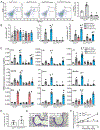Early-life heterologous rhinovirus infections induce an exaggerated asthma-like phenotype
- PMID: 32344055
- PMCID: PMC8097639
- DOI: 10.1016/j.jaci.2020.03.039
Early-life heterologous rhinovirus infections induce an exaggerated asthma-like phenotype
Abstract
Background: Early-life wheezing-associated respiratory tract infection by rhinovirus (RV) is a risk factor for asthma development. Infants are infected with many different RV strains per year.
Objective: We previously showed that RV infection of 6-day-old BALB/c mice induces a mucous metaplasia phenotype that is dependent on type 2 innate lymphoid cells (ILC2s). We hypothesized that early-life RV infection alters the response to subsequent heterologous infection, inducing an exaggerated asthma-like phenotype.
Methods: Wild-type BALB/c mice and Rorafl/flIl7rcre mice lacking ILC2s were treated as follows: (1) sham on day 6 of life plus sham on day 13 of life, (2) RV-A1B on day 6 plus sham on day 13, (3) sham on day 6 plus RV-A2 on day 13, and (4) RV-A1B on day 6 plus RV-A2 on day 13.
Results: Mice infected with RV-A1B at day 6 and sham at day 13 showed an increased number of bronchoalveolar lavage eosinophils and increased expression of IL-13 mRNA but not expression of IFN-γ mRNA (which is indicative of a type 2 immune response), whereas mice infected with sham on day 6 and RV-A2 on day 13 of life demonstrated increased IFN-γ expression (which is a mature antiviral response). In contrast, mice infected with RV-A1B on day 6 before RV-A2 infection on day 13 showed increased expression of IL-13, IL-5, Gob5, Muc5b, and Muc5ac mRNA; increased numbers of eosinophils and IL-13-producing ILC2s; and exaggerated mucus metaplasia and airway hyperresponsiveness. Compared with Rorafl/fl mice, Rorafl/flIl7rcre mice showed complete suppression of bronchoalveolar lavage eosinophils and mucous metaplasia.
Conclusion: Early-life RV infection alters the response to subsequent heterologous infection, inducing an intensified asthma-like phenotype that is dependent on ILC2s.
Keywords: Asthma; IL-13; ILC2; RV-A1B; RV-A2; childhood; early-life; rhinovirus; trained immunity; type 2 innate lymphoid cell.
Copyright © 2020 American Academy of Allergy, Asthma & Immunology. Published by Elsevier Inc. All rights reserved.
Conflict of interest statement
Figures






Comment in
-
Immune responses to rhinoviruses and asthma: Are we 3 steps closer to the door?J Allergy Clin Immunol. 2020 Sep;146(3):513-514. doi: 10.1016/j.jaci.2020.06.031. Epub 2020 Jul 14. J Allergy Clin Immunol. 2020. PMID: 32673613 No abstract available.
References
-
- Lemanske RF Jr, Jackson DJ, Gangnon RE, Evans MD, Li Z, Shult PA, et al. Rhinovirus illnesses during infancy predict subsequent childhood wheezing. J Allergy Clin Immunol 2005; 116:571–7. - PubMed
-
- Moraes TJ, Sears MR. Lower respiratory infections in early life are linked to later asthma. Thorax 2018; 73:105–6. - PubMed
Publication types
MeSH terms
Substances
Grants and funding
LinkOut - more resources
Full Text Sources
Medical
Molecular Biology Databases

